A mess, but an opportunity for improvement
When a team bottoms out the way the Maple Leafs did, naturally there is going to be a lot of anger directed towards the team and its players. Next, factor in the manner in which the team failed to make the playoffs — giving up the most shots ever over an 82-game season and plummeting during to an eight-game losing streak in March, prior to which they were ninth place in the entire league. Then, have it all take place in the tempestuous Toronto hockey market. It goes without saying there is going to be a lot of noise and irrational things said.
It has been my contention over the last few weeks that there are more than a few good pieces in place and that this team isn’t as bad as it seems on the whole. They still sorely lack a real horse at center and their defense needs work, to which I am not oblivious, but if we look at the rest of the Leafs roster and the pieces in place there are quite a few quality players here and even some nice tradable assets. Knowing that, there are some low-fruit-hanging options for management to pick that, if done correctly, will get them back to the playoffs for next season.
Over the next few weeks (because these pieces take a lot of time), I plan on exploring a few of them with the hope of:
- Highlighting what should be relatively easy weaknesses to correct.
- Show that this team isn’t nearly as far off as many appear to believe.
- Provide an offseason view/perspective on this team to keep in mind throughout the summer.
First up is the Leafs‘ depth problem.
When the Leafs made the playoffs in the shortened season, their 7-8-9 forwards according to total raw ice time alone (and excluding Lupul because he didn’t play enough) were Jay McClement, Clarke MacArthur and Leo Komarov, with Matt Frattin just on the outside looking in (he, too, missed a lot of time).
The production the Leafs got from these players was, in retrospect, very underrated. Prorating what they posted over 82 games, this is the kind of production the Leafs received from their 7-8-9 forwards during the truncated 2012-13 season:
| Forwards | Goals | Assists | Points |
|---|---|---|---|
| Jay McClement | 14 | 15 | 29 |
| Clarke MacArthur | 16 | 25 | 41 |
| Leo Komarov | 8 | 10 | 18 |
Compare that to the 82-game prorated totals of the Leafs’ 7-8-9 forwards in 2013-14:
| Forwards | Goals | Assists | Points |
|---|---|---|---|
| Jay McClement | 4 | 6 | 10 |
| David Clarkson | 7 | 8 | 15 |
| Nikolai Kulemin | 11 | 12 | 23 |
Having felt they lost depth last summer, I asked Scott Gordon about these issues in our summer interview series:
[quote_box_center]
AP: Upfront you added Bolland Clarkson, and subtracted Grabovski, MacArthur, Frattin and Komarov. Are you concerned about losing depth?
SG: Well I think with adding Bolland and Clarkson those two players are probably guys that are going to fit our style of play more consistently, with the exception of Komarov. Komarov was a guy we would have loved to have back but obviously he got a good deal in Russia and has to do what’s best for him. But the style of play of Bolland and Clarkson play fits our team identity and we’re excited about them.[/quote_box_center]
Of course, points don’t tell the whole story. Originally, Raymond was supposed to be a third liner on the Leafs but Raymond stepped up and played well when Clarkson was suspended for the first 10 games. There was a legitimate hope that when Clarkson returned it would create the kind of depth good teams possess; Clarkson was supposed to be a top six forward and that would have pushed the productive Raymond down the line-up.
Alas, Clarkson was an unmitigated disaster. There’s no other way to put it. He was leapfrogged by Raymond and in turn became a third liner on the team.
Beyond that, Dave Bolland got injured. Without question, he would have helped the Leafs if he was healthy all season, but depth isn’t depth if it relies on one player.
Bozak was the top six forward that missed the most amount of hockey last season for the Leafs and he only missed 29% of the schedule. The season prior, by comparison, the Leafs top six forward that missed the most time was Joffrey Lupul, who was out for 67% of the year. If Lupul was healthy in 2013 that would have pushed Grabovski out of the top six for the season; he put up a 27 point pace in 2012-13, which would have made the Leafs depth scoring look even better on the whole. That’s the kind of depth the Leafs had a season ago.
Beyond goals-assists-points, the Leafs’ received depth contributions in other areas last season. Jay McClement was a big part of a successful PK, which this season got run over. When McClement was scoring at a good clip and killing penalties, it was justifiable to play him as much as they did; this past season, he did not help the PK nor score much and that significant drop off should have bumped him down the line-up. And yet, he remained a top 9 staple and it hurt their bottom line.
Leo Komarov was able to play a regular shift up and down the line-up, contribute a little offensively, and provide a physical spark. He was also a key contributor on the penalty kill and was able to draw penalties. Komarov was second on the team in penalties drawn in 2013 and drew six more penalties than he took that season. Comparably, Clarkson was fourth on the team in penalties drawn in 2013-14, but he took so many that he was actually a -10 in that category. Add that to the fact that Clarkson didn’t contribute at all on any special team units and the Leafs clearly downgraded here last season, too.
To give you a look at how the Leafs 7-8-9 forwards compared league wide this past season, and without prorating point totals, I charted below the 7-8-9 forwards of every team in the league.
**Note: Raw total ice time was my main indicator of ranking forwards. Ultimately, line combinations and roles dictate how a player does in their ice time, but the total number of ice time is ultimately indicative of a player’s contribution to a game and rank in their forward group. I generally tried to use at least a 40-game cut off to indicate a 7-8-9 forward. I didn’t include deadline pick-ups who played 20 some odd games with a team, but would include them on their original team as a general indicator of what a team was using over the course of the majority of their season (Tuomo Ruutu is with Carolina, for example). I’m sure someone will argue me about one or two of these players, but some of these decisions were tough and I tried to use my best judgement at the end of the day.
| Teams | Players | TOI | Games | Goals | Assists | Points | Total PPG |
|---|---|---|---|---|---|---|---|
| Anaheim | Silfverberg | 14:15 | 52 | 10 | 13 | 23 | 0.5 |
| Selanne | 14:07 | 64 | 9 | 18 | 27 | ||
| Perrault | 13:52 | 69 | 18 | 25 | 43 | ||
| Boston | Smith | 14:42 | 82 | 20 | 31 | 51 | 0.55 |
| Kelly | 14:41 | 57 | 9 | 9 | 18 | ||
| Soderberg | 14:15 | 73 | 16 | 32 | 48 | ||
| Buffalo | Girgensons | 15:18 | 70 | 8 | 14 | 22 | 0.28 |
| Foligno | 15:03 | 74 | 7 | 12 | 19 | ||
| Leino | 14:26 | 58 | 0 | 15 | 15 | ||
| Calgary | Jones | 15:27 | 48 | 9 | 8 | 17 | 0.33 |
| Galiardi | 14:36 | 62 | 4 | 13 | 17 | ||
| Colborne | 14:16 | 80 | 10 | 18 | 28 | ||
| Carolina | Dwyer | 14:39 | 75 | 8 | 14 | 22 | 0.31 |
| Lindholm | 14:31 | 58 | 9 | 12 | 21 | ||
| Ruutu | 14:14 | 57 | 5 | 11 | 16 | ||
| Chicago | Versteeg | 14:06 | 63 | 10 | 19 | 29 | 0.36 |
| Kruger | 13:52 | 81 | 8 | 20 | 28 | ||
| Handzus | 13:38 | 59 | 4 | 12 | 16 | ||
| Colorado | Talbot | 16:19 | 70 | 7 | 18 | 25 | 0.42 |
| Mitchell | 16:16 | 75 | 11 | 21 | 32 | ||
| McGinn | 15:46 | 79 | 19 | 19 | 38 | ||
| Columbus | Atkinson | 15:47 | 79 | 21 | 19 | 40 | 0.44 |
| Letestu | 14:41 | 82 | 12 | 22 | 34 | ||
| Jenner | 14:04 | 72 | 16 | 13 | 29 | ||
| Dallas | Nichushkin | 14:58 | 79 | 14 | 20 | 34 | 0.41 |
| Whitney | 13:57 | 69 | 9 | 23 | 32 | ||
| Roussel | 13:19 | 81 | 14 | 15 | 29 | ||
| Detroit | Bertuzzi | 14:39 | 59 | 9 | 7 | 16 | 0.45 |
| Sheahan | 14:26 | 42 | 9 | 15 | 24 | ||
| Tatar | 14:21 | 73 | 19 | 20 | 39 | ||
| Edmonton | Gordon | 14:21 | 74 | 8 | 13 | 21 | 0.35 |
| Yakupov | 14:18 | 63 | 11 | 13 | 24 | ||
| Arcobello | 15:04 | 41 | 4 | 14 | 18 | ||
| Florida | Kopecky | 15:53 | 49 | 4 | 8 | 12 | 0.31 |
| Huberdeau | 15:39 | 69 | 9 | 19 | 28 | ||
| Gomez | 13:07 | 46 | 2 | 10 | 12 | ||
| LA | King | 15:02 | 77 | 15 | 15 | 30 | 0.28 |
| Lewis | 13:15 | 73 | 6 | 5 | 11 | ||
| Toffoli | 12:57 | 62 | 12 | 17 | 29 | ||
| Minnesota | Cooke | 15:24:00 | 82 | 10 | 18 | 28 | 0.38 |
| Heatley | 14:49:00 | 76 | 12 | 16 | 28 | ||
| Neiderreiter | 14:05:00 | 81 | 14 | 22 | 36 | ||
| Montreal | Galchenyuk | 14:23:00 | 65 | 13 | 18 | 31 | 0.33 |
| Bourque | 14:11:00 | 63 | 9 | 7 | 16 | ||
| Prust | 12:49:00 | 52 | 6 | 7 | 13 | ||
| Nashville | Nystrom | 14:51:00 | 79 | 15 | 6 | 21 | 0.3 |
| Bourque | 13:50:00 | 74 | 9 | 17 | 26 | ||
| Gaustad | 13:48:00 | 75 | 10 | 11 | 21 | ||
| New Jersey | Ryder | 15:46:00 | 82 | 18 | 16 | 34 | 0.34 |
| Brunner | 13:32:00 | 60 | 11 | 14 | 25 | ||
| Gionta | 12:27:00 | 66 | 4 | 7 | 11 | ||
| NYI | Grabner | 14:11:00 | 64 | 12 | 14 | 26 | 0.28 |
| Cizikas | 13:22:00 | 80 | 6 | 10 | 16 | ||
| McDonald | 12:23:00 | 70 | 8 | 10 | 18 | ||
| NYR | Hagelin | 15:31:00 | 72 | 16 | 17 | 33 | 0.37 |
| Pouliot | 13:26:00 | 80 | 15 | 21 | 36 | ||
| Boyle | 12:45:00 | 82 | 6 | 12 | 18 | ||
| Ottawa | Zibanejad | 14:19:00 | 69 | 16 | 17 | 33 | 0.29 |
| Greening | 13:44:00 | 76 | 6 | 11 | 17 | ||
| Neil | 11:48:00 | 76 | 8 | 6 | 14 | ||
| Philadelphia | Schenn | 15:44:00 | 82 | 20 | 21 | 41 | 0.47 |
| Lecalvier | 15:11:00 | 69 | 20 | 17 | 37 | ||
| Downie | 13:32:00 | 51 | 3 | 14 | 17 | ||
| Phoenix | Korpikoski | 16:04:00 | 64 | 9 | 16 | 25 | 0.31 |
| Moss | 14:39:00 | 79 | 8 | 14 | 22 | ||
| Klinkhammer | 11:22:00 | 72 | 11 | 9 | 20 | ||
| Pittsburgh | Adams | 12:27:00 | 82 | 5 | 6 | 11 | 0.22 |
| Gibbons | 11:56:00 | 41 | 5 | 12 | 17 | ||
| Glass | 11:47:00 | 67 | 4 | 9 | 13 | ||
| San Jose | Nieto | 14:04:00 | 66 | 10 | 14 | 24 | 0.35 |
| Havlat | 14:43:00 | 48 | 12 | 10 | 22 | ||
| Kennedy | 12:43:00 | 67 | 4 | 13 | 17 | ||
| St. Louis | Tarasenko | 15:10:00 | 64 | 21 | 22 | 43 | 0.5 |
| Roy | 13:37:00 | 75 | 9 | 28 | 37 | ||
| Morrow | 11:54:00 | 71 | 13 | 12 | 25 | ||
| Tampa | Kucherov | 13:06:00 | 52 | 9 | 9 | 18 | 0.27 |
| Brown | 13:02:00 | 63 | 4 | 15 | 19 | ||
| Thompson | 12:51:00 | 81 | 9 | 7 | 16 | ||
| Toronto | Kulemin | 16:12 | 70 | 9 | 11 | 20 | 0.19 |
| McClement | 14:45 | 81 | 4 | 6 | 10 | ||
| Clarkson | 15:06 | 60 | 5 | 6 | 11 | ||
| Vancouver | Hansen | 15:39:00 | 71 | 11 | 9 | 20 | 0.3 |
| Richardson | 14:54:00 | 73 | 11 | 12 | 23 | ||
| Booth | 13:28:00 | 66 | 9 | 10 | 19 | ||
| Washington | Grabovski | 15:45:00 | 58 | 13 | 22 | 35 | 0.51 |
| Chimera | 15:25:00 | 82 | 15 | 27 | 42 | ||
| Fehr | 14:44:00 | 73 | 13 | 18 | 31 | ||
| Winnipeg | Scheifele | 16:21:00 | 63 | 13 | 21 | 34 | 0.39 |
| Setogouchi | 15:03:00 | 75 | 11 | 16 | 27 | ||
| Halischuk | 11:20:00 | 46 | 5 | 5 | 10 |
By my calculations, the Leafs had the lowest PPG in the league between their 7-8-9 forwards. The combined 41 points they contributed was beat by single individuals on good teams and, by this study, the Leafs had depth worse than that of the lottery teams they ultimately finished in the standings surrounded by.
To put it into perspective, the Sabres had a combined 202 games from their regular 7-8-9 forwards and they combined for 15 goals. The Leafs had a combined 211 games and netted 18 goals. One of those Sabres three forwards, Ville Leino, didn’t score a goal all season.
Circling back to the Scott Gordon interview from the summer, Gordon also stated:
[quote_box_center]SG: Yeah. The makeup of the team is a little bit different. Last year we had what would probably be considered three lines of scoring, maybe not as much depth on each line as far as scoring numbers. Whereas this year our top six is all guys who have had pretty good track records of scoring goals so hopefully that has the same effect as it did last year.[/quote_box_center]
In the summer, the Leafs sacrificed offense in an attempt to get better defensively. The problem was, with Bolland out, they not only didn’t get better defensively, they got worse offensively, too.
I highlighted how the Leafs roster construction is flawed in an end-of-year Notebook. Their top two lines can’t play defense, and their 7-8-9 forwards aren’t nearly good enough defensively to handle the tough minutes. As much as this is an indictment on the 7-8-9 forwards, it should also serve notice of how a team badly needs to receive good two-way play out of at least one of their top two lines to make life easier on the depth forwards when trying to work the match-up game.
This, of course, speaks nothing of what the Leafs were doing with their fourth line.
Three players played over 15 games in a fourth line role and did not contribute a single point (54 games for Orr, 27 for McLaren, 18 for Smithson). D’Amigo and Ashton combined for 54 games and 4 points. Holland (11 in 43), Bodie (10 in 47) and Smith (9 in 27) were at least reasonable contributors. To say nothing of the 12 in 23 Bolland gave the Leafs in his limited time here.
Looking at the Leafs through this prism really confirms what was pretty evident all season: They lived and died by their top forwards, and if they didn’t score the Leafs weren’t going to win. By that token, some of the criticism the top players are receiving is unfair when they definitely played too many minutes and had pretty well the worst support cast in the entire league (no depth scoring, no help on the PK, weren’t good defensively).
With the entire bottom six open for change and new additions, the Leafs have a big opportunity to remake the bottom of their line-up with players that either contribute offensively, defensively, or hopefully even both. Last year, they weren’t getting that from pretty well anyone in the bottom of their line-up and as the season wore on the top players were continuously gassed before they finally crumbled with nothing left to give.
The Leafs aren’t a bottom six away from contending –- still a need a top six 6 C and a top 4 D — but when we look at the scope of what they got from their bottom lines compared to the rest of the league it really paints a picture of how bad their bottom six was in 2013-14, and how making some smart, cheap signings to properly fill out their roster could really elevate this team.
In fact, this will be a nice segue into the second piece of low-hanging fruit on the tree of improvement: The Marlies.


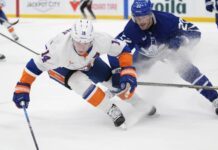







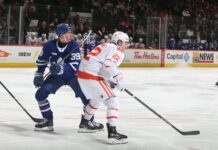


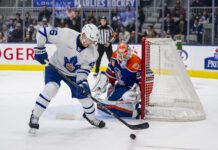




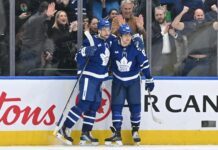




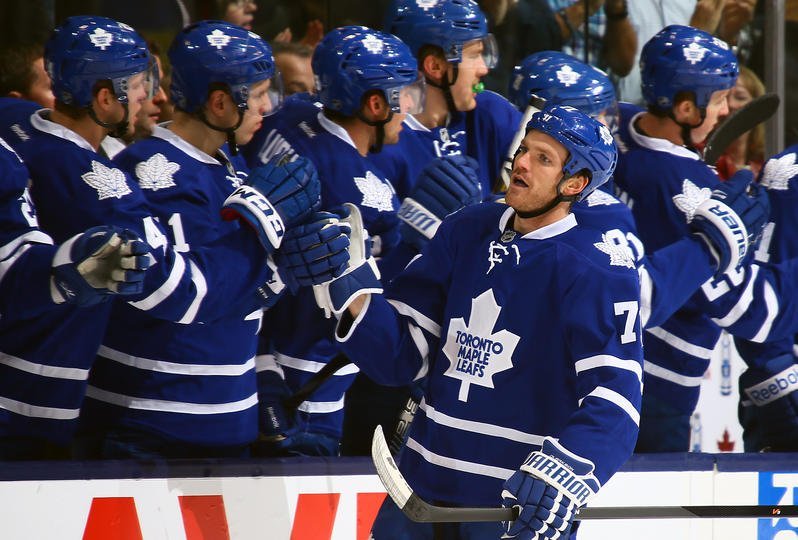
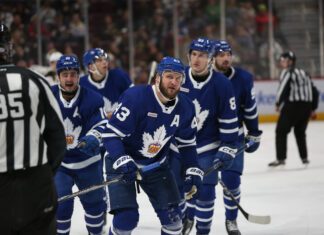






![Craig Berube Post Game, Leafs 6 vs. Sabres 3: “Our team played really hard in front of [Murray]… They were dialed in for him” Craig Berube, Toronto Maple Leafs head coach](https://mapleleafshotstove.com/wp-content/uploads/2024/12/berube-leafs-tor-pg-100x70.jpg)

